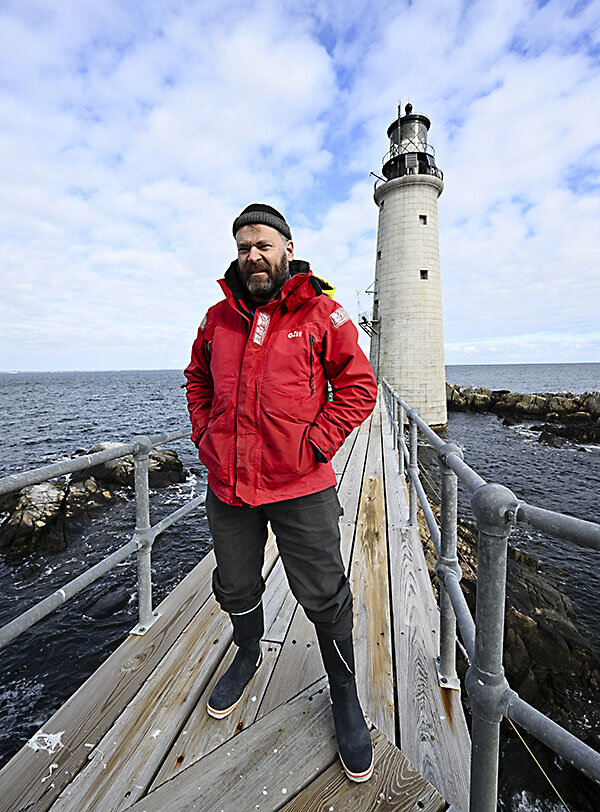America’s last lighthouse keeper is retiring. She, and her light, are ready.
Loading...
| Boston and Hull, Mass.; and Portsmouth, N.H.
When Sally Snowman first stepped foot on Little Brewster Island, home of Boston Light, at age 10, it was love at first sight. “I want to work as a keeper and get married here,” she recalls saying. She did both.
Now, after 20 years as keeper and even longer as a volunteer, she’s ready to retire. Perhaps even more importantly, she says, “the light is ready.”
Why We Wrote This
A story focused onFor many, lighthouses offer a certain nostalgic draw. But as America’s last keeper retires, she insists that the beauty of the beacon need not be locked in the past.
For centuries lighthouses played the crucial role of guiding sailors safely through hazardous waters. Today, some are still active aids to navigation. They also hold a mystical, sentimental power to many, mariners or not, who balked at the news of the last lighthouse keeper retiring. The keeper herself has little patience for a nostalgia that would hamper the future of the icon she has tended for two decades. Ms. Snowman believes the transition will help lighthouses keep shining in the 21st century, rather than fade away.
A spiritual person, she’s touched by all the light has seen and withstood. But she is quietly firm that the transfer of the lighthouse is what’s best. “It’s important to ensure that our national icons are properly cared for,” she says.
When Sally Snowman became the keeper of Boston Light in 2003, she expected the role to last only two years. When she retires on Dec. 31, it will mark 20 years.
Ms. Snowman is the last of the lighthouse keepers in the United States. Her retirement marks the end of 307 years of keepers of Boston Light, originally established in 1716.
When Ms. Snowman first stepped foot on Little Brewster Island at age 10, it was love at first sight. “I want to work as a keeper and get married here,” she recalls saying. She did both. Now, after 20 years as keeper and even longer as a volunteer, she’s ready to retire. Perhaps even more importantly, she says, “the light is ready.”
Why We Wrote This
A story focused onFor many, lighthouses offer a certain nostalgic draw. But as America’s last keeper retires, she insists that the beauty of the beacon need not be locked in the past.
For centuries lighthouses played the crucial role of guiding sailors safely through hazardous waters. Today, some are still active aids to navigation. They also hold a mystical, sentimental power to many, mariners or not, who balked at the news of the last lighthouse keeper retiring. The keeper herself has little patience for a nostalgia that would hamper the future of the icon she has tended for two decades. Ms. Snowman believes the transition will help lighthouses keep shining in the 21st century, rather than fade away.
The appeal of lighthouses reaches far and wide, says Jeremy D’Entremont, who has a weekly podcast, “Light Hearted,” and is the historian for the United States Lighthouse Society. Just recently, his co-host was an 11-year-old girl from Kentucky.
While big ships today have ample navigational technology, their captains “feel welcomed” by lights at harbor mouths, says local Dave Waller, who co-owns nearby Graves Light Station in Boston Harbor. And the need is still practical for smaller crafts. In Canada, there are still about 50 keepers, says Mr. D’Entremont. That’s to keep a human presence on coastlines to spot and assist people in need. “Smaller boaters ... like seeing that light,” he says. “It’s a confirmation.”
The U.S. Coast Guard’s mandate isn’t to restore or preserve historical structures like lighthouses. The military branch will continue to operate the aids to navigation – like the light and foghorn – but the actual upkeep of the physical structures and tours of the island are better suited to a different entity. Though the new owner hasn’t been announced, “there will be a new, vetted steward,” says Ms. Snowman. “The light is ready.”
This isn’t the first time the Coast Guard has looked to transfer ownership of Boston Light. That’s why Ms. Snowman expected her tenure to last only two years. Since 2019, when the Coast Guard initiated the most recent transfer attempt, there’s been “public outcry” over the future of the light, says Ms. Snowman. But, she says, that’s based on “false nostalgia” and misperceptions.
Over her 46 years as a Coast Guard auxiliary volunteer and keeper, Ms. Snowman has become intricately acquainted with the history of the lighthouse and local nautical history. She sews her own Colonial-style dresses for tours. She tried sewing a bonnet once, she says, but the pleats took too long. Now she buys them.
A spiritual person, she’s touched by all the light has seen and withstood. And even those things it has not been able to withstand, such as when it was demolished by the British as they made their last escape from the harbor during the Revolutionary War.
The first time Ms. Snowman did every chore on the island, she says she felt no fear and as if she’d done it all before: “It was coming home.”
Ms. Snowman is quietly firm that the transfer of the lighthouse is what’s best. “It’s important to ensure that our national icons are properly cared for,” she says.
Saving the old structures
Under a process laid out by the National Historic Lighthouse Preservation Act of 2000, there’s a mechanism for ownership of the historic sites to be transferred. Federally owned lighthouses are offered first to other federal agencies, then state and local governments, followed by nonprofits, and eventually private individuals.
Graves Light Station was bought at auction a decade ago after sitting neglected. When Mr. Waller stepped out onto the top deck and saw the panoramic view of Boston and the ocean, he “fell in love.” Born and raised in the area, Mr. Waller as well as his wife lives in a renovated fire station. Upon reflection, Mr. Waller admits to a “pattern of finding derelict historical structures and trying to save them.”
Over the past decade, the Wallers have been restoring Graves Light to its former glory. That has included significant repairs such as rebuilding a bridge that washed away and installing more aesthetic elements like porthole kitchen windows, which Mr. Waller bought at a marine auction. Then there’s the U.S. Lighthouse-issued bell and its clapper – the latter of which he found diving down to a shipwreck. Mr. Waller wants every artifact to be local to Graves Light or New England: “That’s the rule.”
The lifesaving role of lighthouses “is not ancient history,” says Mr. Waller. Just recently, two men had a boating accident and made it to the rocks at the base of Graves Light before they were rescued.
Over the years of research and work, history has returned to Graves Light. In one case, someone mailed an old, handcrafted checkerboard that a former keeper remembered sitting in the lighthouse. After poring over the blueprints (“you couldn’t have given me a better gift”), Mr. Waller was able to confirm the name of the engineer who designed the lighthouse for his descendants. There’s also the enormity of moments described in the logbooks. One day during World War II, a keeper found six German spies in a rowboat. Another entry described finding two men naked in an overturned canoe. “We gave them fresh clothes, they gave us false names,” the entry reads.
The man the Wallers outbid is also a lighthouse enthusiast who owns two others. After the auction, Boston-based philanthropist Bobby Sager reached out to Mr. Waller asking to buy Graves Light. Mr. Waller declined, but eventually the two reached an agreement. Now, they’re co-owners and good friends, says Mr. Waller – who was “lighthouse rich and cash poor” after the purchase. Mr. Sager helps to finance the restoration and gathers at the lighthouse with friends – such as the musician Sting, who sang “Roxanne” from the top of the lighthouse in what Mr. Waller described as a surreal moment.
Investing in the future
There’s a barn-raising aspect to the lighthouse’s restoration, from Mr. Sager’s investment, to Mr. Waller’s carpenter relatives who built curved cabinetry and bunks, to the many New England locals who have crafted traditional parts. “People think, ‘Oh, I guess if you have enough money you can do anything,’” says Mr. Waller, as he sits inside the Fresnel lens fitting screws. “But even if you did have enough money, it wouldn’t be enough. … You have to drive it.”
Mr. Waller has spent years gathering glass pieces and researching how to rebuild Graves Light’s 40,000-pound Fresnel lens. Finally, he found a company in Australia that was able to piece the parts together and cast the brass frame. Now, he’s just waiting for the light to be officially commissioned by the Coast Guard. It will be the first time the Coast Guard has agreed to go from a modern LED light back to a Fresnel lens.
The same people studying the history of lighthouses see a future for them, too, not only as landmarks but also as navigational aids.
Though Ms. Snowman is the last official keeper of Boston Light, she’ll never be far. She lives in nearby Hull, the town on a spit of land opposite the light. And she’s open to continuing to give talks and offer tours as a volunteer. By her tally, Ms. Snowman was logging 4,000 hours of work and volunteering per year.
No matter who the new owner is, they’ll have to allow tours of the site, so Ms. Snowman wouldn’t be surprised if she’s still involved. “Give me a National Park volunteer hat,” she says. “I’ll just be one of the tour guides.”
Editor’s note: This story has been updated to correct the number of hours Ms. Snowman worked and volunteered per year.











